What happened on 7 April?
The bombardment continued for a second day, with dozens of people reportedly killed or injured by conventional munitions before the suspected chemical attack.
Activists from the Violations Documentation Center (VDC), which records alleged violations of international law in Syria, reported two separate incidents of bombs believed to contain toxic substances being dropped by the Syrian Air Force.
The first occurred at approximately 16:00 (13:00 GMT) and saw the Saada bakery on Omar Ibn Al-Khattab street in north-western Douma targeted, the VDC said.
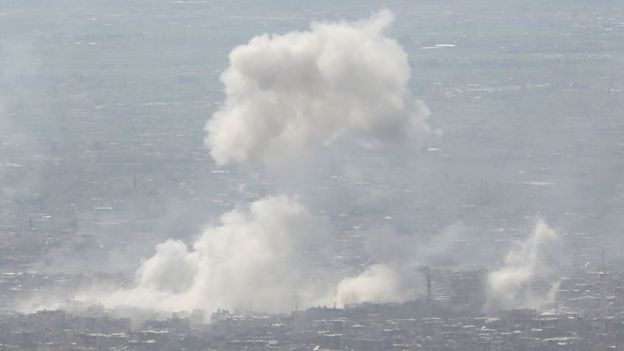 Image copyrightAFP
Image copyrightAFP
Image captionActivists say Douma came under intense aerial bombardment on Saturday
It cited a member of the Syria Civil Defence, whose rescue workers are widely known as the White Helmets, as saying he smelt chlorine in the air after the strike, but that he could not determine its source.
"We later discovered the bodies of people who had suffocated from toxic gases. They were in closed spaces, sheltering from the barrel bombs, which may have caused their quick death as no-one heard their screams," he added.
The VDC said the second incident took place not far to the east, near Martyrs' Square, at approximately 19:30.
At 19:45, more than 500 patients - most of them women and children - were brought to medical facilities with symptoms indicative of exposure to a chemical agent, according to the Syria Civil Defence and the Syrian American Medical Society (SAMS), a relief organisation that supports hospitals in rebel-held areas.
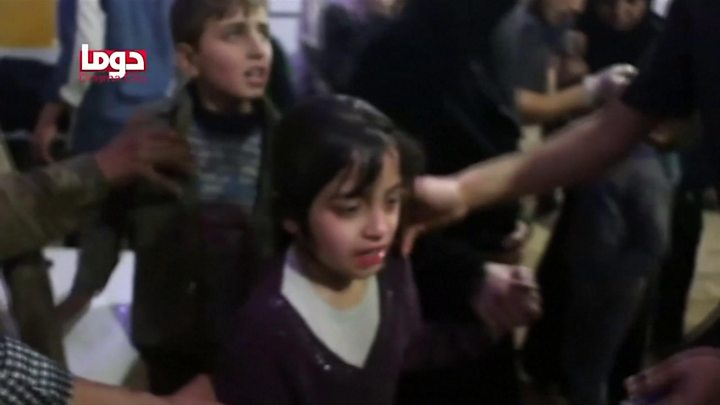
Media captionUnverified video shows children being treated after the alleged gas attack
The patients showed signs of "respiratory distress, central cyanosis (blue skin or lips), excessive oral foaming, corneal burns, and the emission of chlorine-like odour", a joint statement issued on Sunday said. One woman who died had convulsions and pinpoint pupils.
Rescue workers searching homes in the affected area also found the bodies of people with oral foaming, cyanosis, and corneal burns, the statement added.
The Union of Medical Care and Relief Organizations (UOSSM), which supports hospitals in rebel-held Syria, also said it received reports of two incidents.
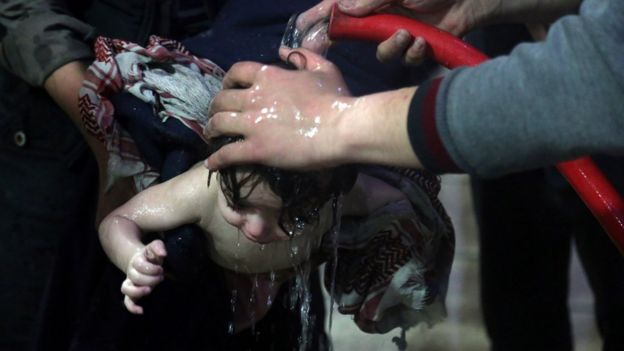 Image copyrightREUTERS
Image copyrightREUTERS
Image captionPatients were hosed down with water to remove any chemicals on their skin
People were treated for breathing difficulties and irritation of the eyes following the first, the UOSSM said. After the second, patients were brought to hospital smelling strongly of a chlorine-like substance and presenting symptoms that included cyanosis, foaming of the mouth, and cornea irritation, it added.
A medical student working at a hospital told the BBC he had treated a man who died. "His pupils were dilated and he had foam in his mouth. His heart was very slow. Then he coughed blood into his mouth as well," he said.
Two videos circulated by the opposition activist group Douma Revolution showed what it said were the bodies of children, women and men found in one building, which is believed to be located south-west of Martyrs' Square. Some had foam coming out of their mouths and noses.
How many people died?
The World Health Organization said it had received reports from its local "health cluster partners" of 43 deaths related to symptoms consistent with exposure to highly toxic chemicals".
The Syria Civil Defence and SAMS said rescue workers found 42 people dead in their homes. One person was declared dead on arrival at a hospital, and another six died while receiving treatment, they added. An earlier, now deleted tweet by the Syria Civil Defence put the number dead at more than 150.
The UOSSM initially reported that 70 people were confirmed dead. On Monday, it revised down the figure to at least 42, but said it was expected to rise.
The Syrian Observatory for Human Rights, a UK-based monitoring group, said air strikes on 6 and 7 April killed almost 100 people. It said they included 21 who died as a result of suffocation, but that it was unable to identify the cause.
The British investigative journalism website, Bellingcat, said it had counted at least 34 bodies in the two videos circulated by Douma Revolution.
Bellingcat also assessed that the building near Martyrs' Square where the bodies were filmed was visited by Russian military personnel on 9 April.
What could they have been exposed to?
Experts say it is impossible to know whether a person has been exposed to a chemical agent from looking at a video or photo. The only way to confirm contamination is to take samples and analyse them in a laboratory. However, the UN and other international humanitarian organisations were unable to get into Douma because of the government's siege.
The director general of the Organisation for the Prohibition of Chemical Weapons (OPCW), Ahmet Uzumcu, said on 16 April that its experts considered the allegations of chemical weapons use to be "credible" and "requiring further investigation".
An OPCW fact-finding team arrived in Damascus on 14 April, but "security issues" cited by Syrian and Russian officials had prevented them from deploying to Douma, Mr Uzumcu added.
Image copyrightEPA
Image captionA fact-finding team from the OPCW has travelled to Damascus to investigate the allegations
The Syria Civil Defence and SAMS believe those who died suffocated as a result of exposure to toxic chemicals, most likely an organophosphate - a compound grouping associated with pesticides and nerve agents.
The UOSSM also concluded that the symptoms of the casualties were consistent with exposure to a nerve agent, possibly one mixed with chlorine. Dr Raphal Pitti of UOSSM France said he thought "chlorine was used to conceal the use of Sarin", a nerve agent.
On 13 April, the US said it assessed "with confidence that the Syrian regime used chemical weapons".
The conclusion was "based on descriptions of the attack in multiple media sources, the reported symptoms experienced by victims, videos and images showing two assessed barrel bombs from the attack, and reliable information indicating co-ordination between Syrian military officials before the attack".
It added: "A significant body of information points to the regime using chlorine in its bombardment of Douma, while some additional information points to the regime also using the nerve agent Sarin."
The following day, France released a document based on "open source information and declassified intelligence", which it said indicated that Syrian military officials "co-ordinated what appears to be the use of chemical weapons containing chlorine on Douma".
What does the Syrian government say?
The Syrian government, which has repeatedly denied ever using chemical weapons, accused rebels of "fabricating" the reports.
Syria's permanent representative to the UN, Bashar al-Jaafari, accused Western powers of falsely accusing the government "to prepare the ground for an aggression against my country, just as the United States and the United Kingdom did in Iraq in 2003".
Russia's Foreign Minister Sergei Lavrov said on 13 April that it had "irrefutable evidence that this was yet another attack, staged with the participation of special services of one state that is striving to be at the forefront of the Russophobic campaign".
Image copyrightAFP
Image captionSyrian government ground forces advanced towards Douma on Saturday
Mr Lavrov avoided naming that country, but Russian defence ministry spokesman Maj Gen Igor Konashenkov later said the UK was "directly involved in the provocation". He did not provide any evidence and a British diplomat called the allegation "bizarre" and a "blatant lie".
Russia's permanent representative to the UN, Vassily Nebenzia, told the Security Council on 9 April that Russian military specialists had visited Douma and taken soil samples that showed no presence of nerve agents or substances containing chlorine.
"At the local hospital, no-one with symptoms of sarin or chlorine poisoning had been admitted," he added. "No bodies of people who had died from being poisoned were found, and the medical staff and residents had no information about where they might have been buried.
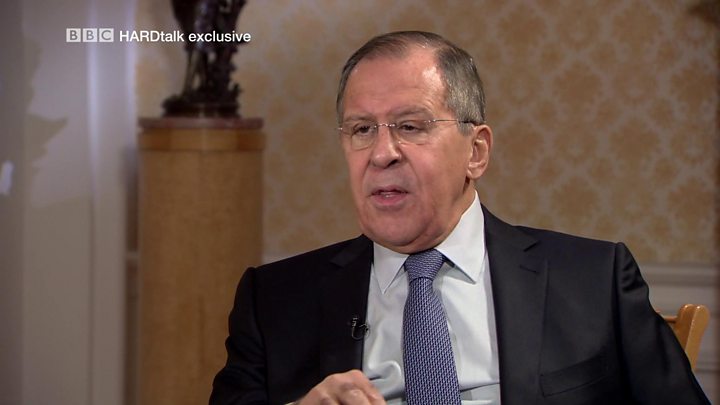
Media captionRussia's foreign minister says the only evidence of a chemical attack came from the media
He also noted that an opposition activist had posted a video purportedly showing a chemical bomb made out of yellow gas canister that had landed in a bedroom in a building in Douma. Mr Nebenzia said the video was staged, adding: "The trajectory of the alleged bomb is entirely unnatural. It fell through the roof and landed gently on a wooden bed without damaging it in any way and was clearly placed there."
The US said it had no information to suggest Jaysh al-Islam had ever used chemical weapons, and that it was unlikely that the opposition could have fabricated the number of reports that came from Douma on 7 April and "deceived multiple media outlets while evading our detection".
How has the international community reacted?
United Nations Secretary General António Guterres said he was outraged by the reports from Douma and warned that "any confirmed use of chemical weapons, by any party to the conflict and under any circumstances, is abhorrent and a clear violation of international law".
Hours before the OPCW fact-finding team arrived in Damascus on 14 April, the US, UK and France carried out missile strikes on three sites they said were "specifically associated with the Syrian regime's chemical weapons programme".
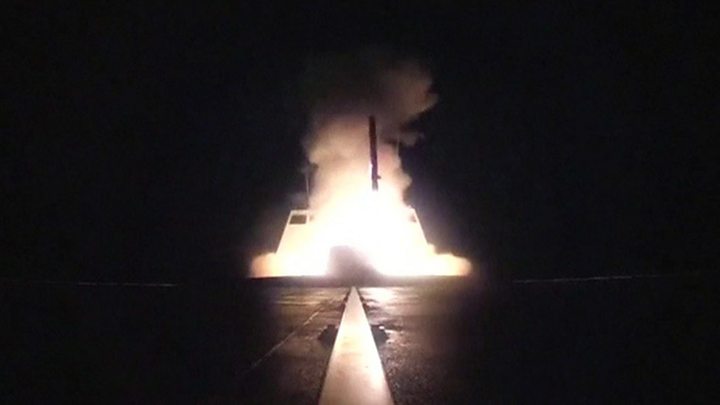
Media captionHow the Western attacks on Syria's suspected chemical weapons sites unfolded
The US military said warships and jets launched 105 missiles that hit a branch of the Scientific Studies and Research Centre (SSRC) in the capital's Barzeh district, the Him Shinshar chemical weapons storage facility west of the city of Homs, and a nearby chemical weapons bunker.
US President Donald Trump said he wanted "to establish a strong deterrent against the production, spread, and use of chemical weapons".
The Syrian foreign ministry denounced "the barbaric aggression", which it said would "not affect in any way the determination and insistence of the Syrian people and their heroic armed forces".
When were chemical weapons used before?
In August 2013, rockets containing Sarin were fired at several opposition-held suburbs in the Eastern and Western Ghouta, killing hundreds of people. UN experts confirmed that Sarin was used in the attack, but they were not asked to ascribe any blame.
Western powers said only Syrian government forces could have carried out the attack. President Assad denied the allegation, but he did agree to sign the Chemical Weapons Convention and destroy Syria's declared chemical arsenal.
Experts from a joint UN-OPCW mission also said they were confident that government forces used Sarin in an attack in April 2017 on the rebel-held Khan Sheikhoun, which reportedly killed more than 80 people.
President Assad dismissed the attack as a fabrication, but the US carried a cruise missile strike on a Syrian airbase in retaliation.
The UN-OPCW mission also found that government forces used chlorine as a weapon on at least three occasions during the civil war.
The bombardment continued for a second day, with dozens of people reportedly killed or injured by conventional munitions before the suspected chemical attack.
Activists from the Violations Documentation Center (VDC), which records alleged violations of international law in Syria, reported two separate incidents of bombs believed to contain toxic substances being dropped by the Syrian Air Force.
The first occurred at approximately 16:00 (13:00 GMT) and saw the Saada bakery on Omar Ibn Al-Khattab street in north-western Douma targeted, the VDC said.

Image captionActivists say Douma came under intense aerial bombardment on Saturday
It cited a member of the Syria Civil Defence, whose rescue workers are widely known as the White Helmets, as saying he smelt chlorine in the air after the strike, but that he could not determine its source.
"We later discovered the bodies of people who had suffocated from toxic gases. They were in closed spaces, sheltering from the barrel bombs, which may have caused their quick death as no-one heard their screams," he added.
The VDC said the second incident took place not far to the east, near Martyrs' Square, at approximately 19:30.
At 19:45, more than 500 patients - most of them women and children - were brought to medical facilities with symptoms indicative of exposure to a chemical agent, according to the Syria Civil Defence and the Syrian American Medical Society (SAMS), a relief organisation that supports hospitals in rebel-held areas.

Media captionUnverified video shows children being treated after the alleged gas attack
The patients showed signs of "respiratory distress, central cyanosis (blue skin or lips), excessive oral foaming, corneal burns, and the emission of chlorine-like odour", a joint statement issued on Sunday said. One woman who died had convulsions and pinpoint pupils.
Rescue workers searching homes in the affected area also found the bodies of people with oral foaming, cyanosis, and corneal burns, the statement added.
The Union of Medical Care and Relief Organizations (UOSSM), which supports hospitals in rebel-held Syria, also said it received reports of two incidents.

Image captionPatients were hosed down with water to remove any chemicals on their skin
People were treated for breathing difficulties and irritation of the eyes following the first, the UOSSM said. After the second, patients were brought to hospital smelling strongly of a chlorine-like substance and presenting symptoms that included cyanosis, foaming of the mouth, and cornea irritation, it added.
A medical student working at a hospital told the BBC he had treated a man who died. "His pupils were dilated and he had foam in his mouth. His heart was very slow. Then he coughed blood into his mouth as well," he said.
Two videos circulated by the opposition activist group Douma Revolution showed what it said were the bodies of children, women and men found in one building, which is believed to be located south-west of Martyrs' Square. Some had foam coming out of their mouths and noses.
How many people died?
The World Health Organization said it had received reports from its local "health cluster partners" of 43 deaths related to symptoms consistent with exposure to highly toxic chemicals".
The Syria Civil Defence and SAMS said rescue workers found 42 people dead in their homes. One person was declared dead on arrival at a hospital, and another six died while receiving treatment, they added. An earlier, now deleted tweet by the Syria Civil Defence put the number dead at more than 150.
The UOSSM initially reported that 70 people were confirmed dead. On Monday, it revised down the figure to at least 42, but said it was expected to rise.
The Syrian Observatory for Human Rights, a UK-based monitoring group, said air strikes on 6 and 7 April killed almost 100 people. It said they included 21 who died as a result of suffocation, but that it was unable to identify the cause.
The British investigative journalism website, Bellingcat, said it had counted at least 34 bodies in the two videos circulated by Douma Revolution.
Bellingcat also assessed that the building near Martyrs' Square where the bodies were filmed was visited by Russian military personnel on 9 April.
What could they have been exposed to?
Experts say it is impossible to know whether a person has been exposed to a chemical agent from looking at a video or photo. The only way to confirm contamination is to take samples and analyse them in a laboratory. However, the UN and other international humanitarian organisations were unable to get into Douma because of the government's siege.
The director general of the Organisation for the Prohibition of Chemical Weapons (OPCW), Ahmet Uzumcu, said on 16 April that its experts considered the allegations of chemical weapons use to be "credible" and "requiring further investigation".
An OPCW fact-finding team arrived in Damascus on 14 April, but "security issues" cited by Syrian and Russian officials had prevented them from deploying to Douma, Mr Uzumcu added.
Image copyrightEPA
Image captionA fact-finding team from the OPCW has travelled to Damascus to investigate the allegations
The Syria Civil Defence and SAMS believe those who died suffocated as a result of exposure to toxic chemicals, most likely an organophosphate - a compound grouping associated with pesticides and nerve agents.
The UOSSM also concluded that the symptoms of the casualties were consistent with exposure to a nerve agent, possibly one mixed with chlorine. Dr Raphal Pitti of UOSSM France said he thought "chlorine was used to conceal the use of Sarin", a nerve agent.
On 13 April, the US said it assessed "with confidence that the Syrian regime used chemical weapons".
The conclusion was "based on descriptions of the attack in multiple media sources, the reported symptoms experienced by victims, videos and images showing two assessed barrel bombs from the attack, and reliable information indicating co-ordination between Syrian military officials before the attack".
It added: "A significant body of information points to the regime using chlorine in its bombardment of Douma, while some additional information points to the regime also using the nerve agent Sarin."
The following day, France released a document based on "open source information and declassified intelligence", which it said indicated that Syrian military officials "co-ordinated what appears to be the use of chemical weapons containing chlorine on Douma".
What does the Syrian government say?
The Syrian government, which has repeatedly denied ever using chemical weapons, accused rebels of "fabricating" the reports.
Syria's permanent representative to the UN, Bashar al-Jaafari, accused Western powers of falsely accusing the government "to prepare the ground for an aggression against my country, just as the United States and the United Kingdom did in Iraq in 2003".
Russia's Foreign Minister Sergei Lavrov said on 13 April that it had "irrefutable evidence that this was yet another attack, staged with the participation of special services of one state that is striving to be at the forefront of the Russophobic campaign".
Image copyrightAFP
Image captionSyrian government ground forces advanced towards Douma on Saturday
Mr Lavrov avoided naming that country, but Russian defence ministry spokesman Maj Gen Igor Konashenkov later said the UK was "directly involved in the provocation". He did not provide any evidence and a British diplomat called the allegation "bizarre" and a "blatant lie".
Russia's permanent representative to the UN, Vassily Nebenzia, told the Security Council on 9 April that Russian military specialists had visited Douma and taken soil samples that showed no presence of nerve agents or substances containing chlorine.
"At the local hospital, no-one with symptoms of sarin or chlorine poisoning had been admitted," he added. "No bodies of people who had died from being poisoned were found, and the medical staff and residents had no information about where they might have been buried.

Media captionRussia's foreign minister says the only evidence of a chemical attack came from the media
He also noted that an opposition activist had posted a video purportedly showing a chemical bomb made out of yellow gas canister that had landed in a bedroom in a building in Douma. Mr Nebenzia said the video was staged, adding: "The trajectory of the alleged bomb is entirely unnatural. It fell through the roof and landed gently on a wooden bed without damaging it in any way and was clearly placed there."
The US said it had no information to suggest Jaysh al-Islam had ever used chemical weapons, and that it was unlikely that the opposition could have fabricated the number of reports that came from Douma on 7 April and "deceived multiple media outlets while evading our detection".
How has the international community reacted?
United Nations Secretary General António Guterres said he was outraged by the reports from Douma and warned that "any confirmed use of chemical weapons, by any party to the conflict and under any circumstances, is abhorrent and a clear violation of international law".
Hours before the OPCW fact-finding team arrived in Damascus on 14 April, the US, UK and France carried out missile strikes on three sites they said were "specifically associated with the Syrian regime's chemical weapons programme".

Media captionHow the Western attacks on Syria's suspected chemical weapons sites unfolded
The US military said warships and jets launched 105 missiles that hit a branch of the Scientific Studies and Research Centre (SSRC) in the capital's Barzeh district, the Him Shinshar chemical weapons storage facility west of the city of Homs, and a nearby chemical weapons bunker.
US President Donald Trump said he wanted "to establish a strong deterrent against the production, spread, and use of chemical weapons".
The Syrian foreign ministry denounced "the barbaric aggression", which it said would "not affect in any way the determination and insistence of the Syrian people and their heroic armed forces".
When were chemical weapons used before?
In August 2013, rockets containing Sarin were fired at several opposition-held suburbs in the Eastern and Western Ghouta, killing hundreds of people. UN experts confirmed that Sarin was used in the attack, but they were not asked to ascribe any blame.
Western powers said only Syrian government forces could have carried out the attack. President Assad denied the allegation, but he did agree to sign the Chemical Weapons Convention and destroy Syria's declared chemical arsenal.
Experts from a joint UN-OPCW mission also said they were confident that government forces used Sarin in an attack in April 2017 on the rebel-held Khan Sheikhoun, which reportedly killed more than 80 people.
President Assad dismissed the attack as a fabrication, but the US carried a cruise missile strike on a Syrian airbase in retaliation.
The UN-OPCW mission also found that government forces used chlorine as a weapon on at least three occasions during the civil war.


